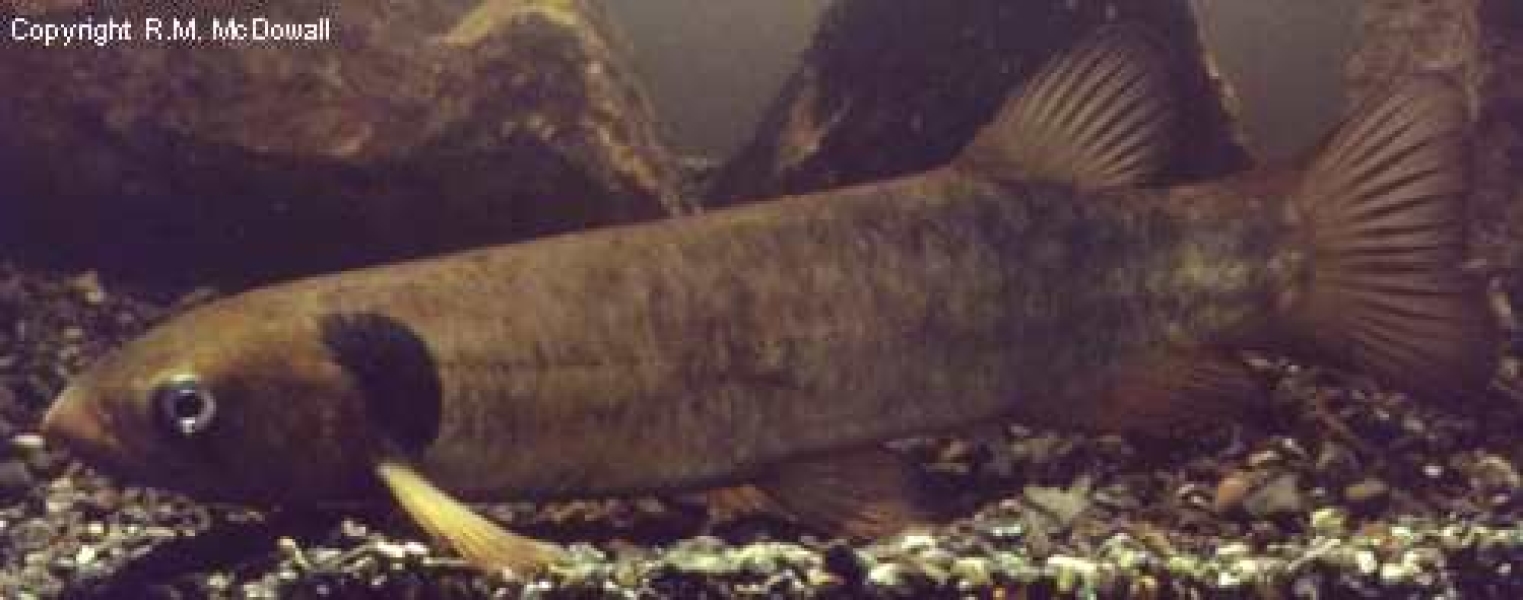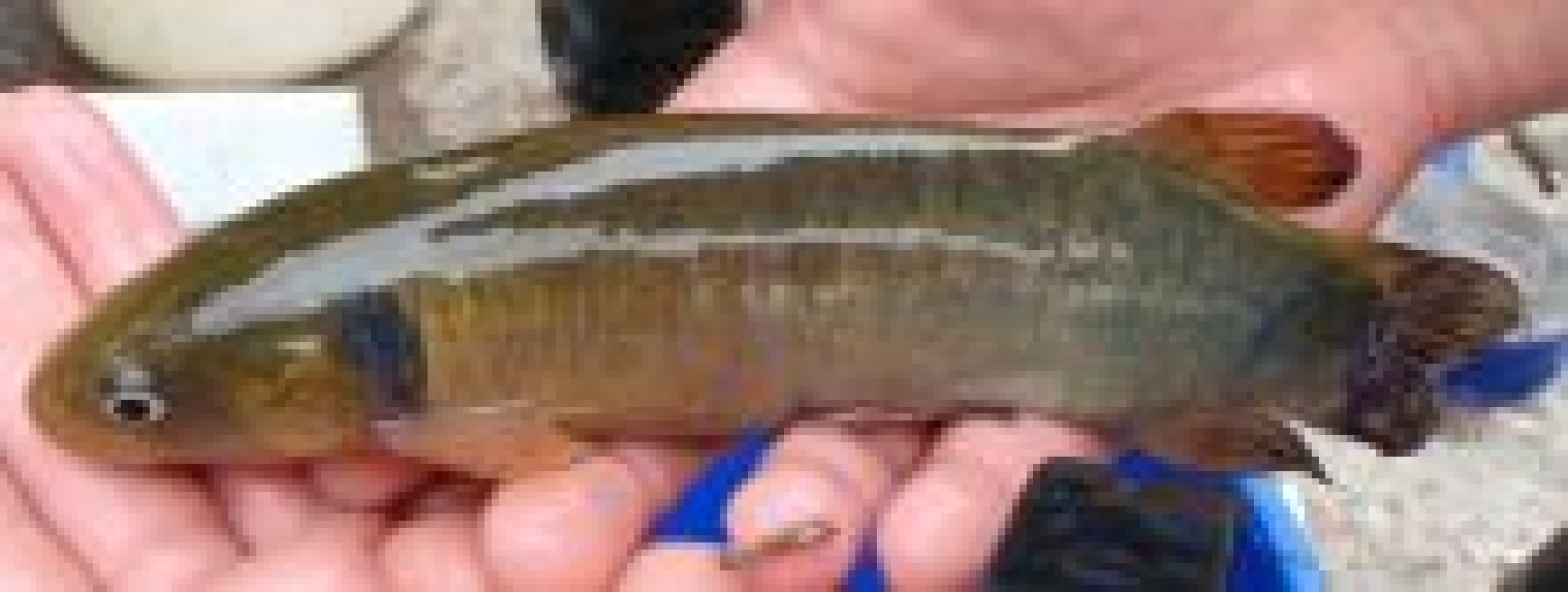Has a receding lower jaw and black spots behind the head.
Common name: Shortjaw kōkopu Scientific name: Galaxias postvectis Māori names: includes kōkopu
About this species
The shortjaw kōkopu is a grey olive colour with very prominent blue/black splotches behind the gills. They can be found in relatively small, bouldery, intact bush-covered streams within Aotearoa seeking refuge beneath large boulders. These fish are thought to be fairly uncommon; however, this could be due to lower sampling of their secretive habitats. They are easily identified by large black patch behind the gill cover.
Shortjaw kōkopu are considered to be a threatened species in gradual decline. Recently the first known non-diadromous shortjaw kōkopu was discovered, implying that this fish is able to form completely land locked populations.
Traditional knowledge
Kōkopu species were taken at night in streams (when they are most active) by Māori using a torch and a scoop net. The fish are relatively easy to capture as they are slow moving unless frightened.
Impacts on shortjaw kōkopu
Deforestation is likely to have negatively impacted shortjaw kōkopu as this species resides in unmodified streams. Migration barriers may also have played a part in declining fish numbers by restricting access to available upstream habitats. The shortjaw kōkopu is capable of climbing relatively high and steep falls, penetrating far inland (but not as far as kōaro or banded kōkopu). Shortjaw kōkopu prefer to live in streams with a slightly alkaline pH of 8.3.
References and further reading
Find papers relevant to all Aotearoa freshwater fish on our reference page
Inanga, Banded kōkopu, Giant kōkopu, Shortjaw kōkopu, and Kōaro
- Baker C. F., Smith, J. P. 2007. Habitat use by banded kokopu (Galaxias fasciatus) and giant kokopu (G. argenteus) co-occurring in streams draining the Hakarimata Range, New Zealand. New Zealand Journal of Marine and Freshwater Research 41: 25—33.
- Baker, C. F. 2003. Effects of adult pheromones on the avoidance of suspended sediment by migratory banded kokopu juveniles. Journal of Fish Biology 62: 386-394.
- Baker, C., Carton, G., Fine, J., Sorensen, P. 2005. Banded kokopu: sniffing out a good home. Water and Atmosphere 13: 14-15.
- Bonnett, M. L., Sykes, J. R. E. 2002. Habitat preferences of giant kokopu, Galaxias argenteus. New Zealand Journal of Marine and Freshwater Research 36: 13-24.
- Bonnett, M. L., Lambert, P.W. 2002. Diet of giant kokopu, Galaxias argenteus. New Zealand Journal of Marine and Freshwater Research 36: 361-369.
- David, B. O., Closs, G. P., Crow, S. K., Hansen, E. A. 2007. Is diel activity determined by social rank in a drift- feeding stream fish dominance hierarchy? Animal Behaviour 74: 259-263
- David, B. O., Stoffels, R. J. 2003. Spatial organisation and behavioural interaction of giant kokopu (Galaxias argenteus) in two stream pools differing in fish density. New Zealand Journal of Marine and Freshwater Research 37: 315-322
- Department of Conservation. 2005. New Zealand large galaxiid recovery plan, 2003–13, Shortjaw kokopu, giant kokopu, banded kokopu, and koaro. Threatened Species Recovery Plan 55.
- Main, M. R. 1988. Factors influencing the distribution of kokopu and koaro (Pices: Galaxiidae). University of Canterbury, MSc Thesis.
- McDowall, R. M. 1984. The New Zealand Whitebait Book. AH & AW Reed Ltd., Wellington. 210 p.
- Rowe, D. 1991. Native fish habitat and distribution. Freshwater Catch 45: 4-6.
- Rowe, D. K. 1993. Disappearance of kōaro, Galaxias brevipinnis, from Lake Rotopounamu, New Zealand, following the introduction of smelt, Retropinna retropinna. Environmental Biology of Fishes 36: 329-336.
- Rowe, D. K., Hicks, M., Richardson, J. 2000. Reduced abundance of banded kokopu (Galaxias fasciatus) and other native fish in turbid rivers of the North Island of New Zealand. New Zealand Journal of Marine and Freshwater Research 34: 545-556.
- Rowe, D., Graynoth, E., James, G., Taylor, M., Hawke, L. 2003. Influence of turbidity and fluctuating water levels on the abundance and depth distribution of small, benthic fish in New Zealand alpine lakes. Ecology of Freshwater Fish 12: 216-227.
- Richardson, J., Taylor, M. 2002. A guide to restoring inanga habitat. NIWA Science and Technology Series No. 50. 29 p.
- Richardson, J., Jowett, I. 2005. Restoring streams for freshwater fish. NIWA Science and Technology Series No. 53. 55 p.


